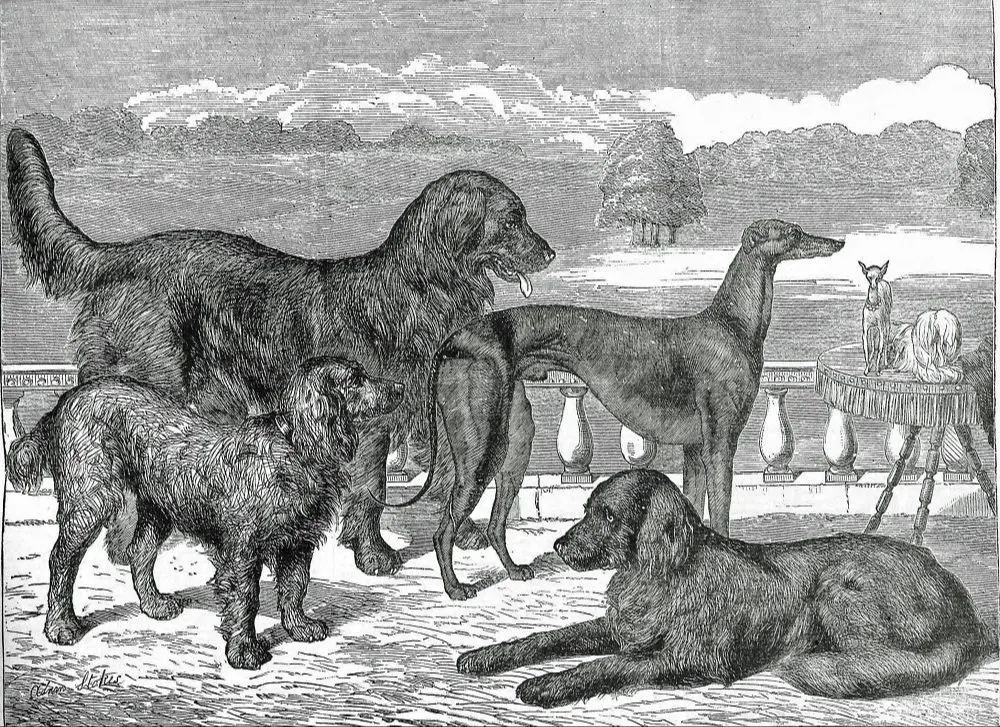Defining Purebred Dogs
According to the American Kennel Club, purebred dogs are “dogs bred from members of the same breed or variety, with written documentation that they are descended from ancestors of that breed going back a minimum of three generations.”
Each breed has an established standard that outlines the physical characteristics, temperament, abilities and attributes that are desired in that particular breed. These standards were developed by breed clubs and organizations like the AKC to preserve the qualities that make each breed unique.
The purpose of purebred dogs is to produce animals that consistently exhibit the physical and behavioral traits set forth in the breed standard. By carefully selecting dogs that closely match the standard to breed together, purebred dogs pass down desired qualities through generations. This level of predictability allows breeders to produce dogs suited for various working roles, competitions and companionship.
Origins of Dog Breeds

The domestic dog originated from wild wolves tens of thousands of years ago. As human civilization advanced, particular dog breeds emerged through selective breeding to perform specific jobs and roles. Many modern dog breeds trace their origins back to the Victorian era in the mid-late 1800s, when kennel clubs were formed and people became interested in standardizing breeds for show competitions. The emphasis on “pure bloodlines” grew during this time.
Victorian dog fanciers aimed to develop distinct breeds with predictable traits related to appearance, size, coat, temperament and working ability. They did this by breeding dogs with similar characteristics to one another, and preventing outcrossing with other breeds. Over generations, this created genetically isolated breeds that “bred true” for signature looks and behaviors.
While early breeders were not always meticulous aboutdocumentation and breeding records, the general origins of most modern breeds can be traced back to this 19th century purebreeding boom and the establishment of breed registries and kennel clubs.
Genetics of Purebred Dogs
Purebred dog populations are created through closed breeding within a limited gene pool. Breeders intentionally breed dogs with similar physical and behavioral characteristics over many generations to consolidate the desired traits and create a new breed. This closed breeding results in a relatively small founding population and limited genetic diversity within purebred dogs of a particular breed.
The limited gene pool means purebred dogs are more likely to inherit genetic diseases or physical issues prevalent in their breed. Certain breeds are predisposed to conditions such as hip dysplasia, heart problems, cancers, and other ailments linked to their genetics. Mixed breed dogs with a more varied genetic background tend to have increased hybrid vigor and fewer instances of breed-specific conditions.
Outcrossing by mixing two purebreds of the same breed is sometimes used to widen the gene pool and reduce the frequency of inherited diseases. However, most kennel clubs strictly regulate which dogs can contribute to a purebred line, making it difficult to introduce new genetics into an established breed. The lack of genetic diversity remains an ongoing challenge among many purebred populations.
Outcrossing in Purebred Lines
Outcrossing refers to the practice of introducing outside blood from another breed into a purebred line. This is done by breeding a purebred dog to a different purebred dog breed. Outcrossing can help increase the genetic diversity within a breed and reduce the prevalence of inherited disorders caused by a limited gene pool.
However, outcrossing is controversial among many breeders and breed clubs. They view it as diluting the purity of the breed and fear it could change the appearance and temperament of their dogs. The American Kennel Club requires breeds it recognizes to breed true to type.

On the other hand, some argue that occasional, well-planned outcrossing is necessary for the health of many breeds. Inbreeding within closed gene pools has led to severe health issues in some breeds. Ethical outcrossing programs can carefully introduce new genes to improve health, while maintaining breed characteristics. However, outcrossing does carry risks if not performed carefully over multiple generations. The benefits vs risks of outcrossing are debated within the dog breeding community.
Accidental Breeding
Even the most responsible purebred dog owners can experience accidental breedings. Purebred dogs in heat have an incredibly strong drive to mate, and can be crafty in finding ways to get to intact males. While reputable breeders often go to great lengths to prevent accidental litters, things can and do happen. An accidental breeding of two purebred dogs is unlikely to produce puppies that meet the breed standard. The litter is also likely to introduce non-purebred genes, as there was no control over the sire. Accidental litters should not be represented as purebred without DNA proof.
DNA Testing for Purebred Dogs
DNA tests have become a popular tool for dog owners and breeders to validate the ancestry and pedigree of purebred dogs. Companies like Embark, Wisdom Panel, and many others now offer genetic screening to check breed ancestry and lineage.
These dog DNA tests work by analyzing a dog’s genes across thousands of genetic markers and comparing them against breed-specific genetic signatures. This allows the tests to identify the relative percentage of over 350 different breeds in a mixed breed dog. For purebreds, the tests can confirm whether a dog’s DNA aligns with the expected breed signature.
While genetic screening provides useful pedigree information, the tests do have limitations. DNA cannot identify every purebred ancestor beyond 3-4 generations back. Environmental factors and epigenetics also influence how genes are expressed. And DNA alone cannot validate whether breeders carefully followed official breeding standards and protocols.
Percentage of Purebred Dogs
It’s difficult to get an exact percentage of how many pet dogs are considered purebred. Some estimates suggest around 40-45% of pet dogs in the United States are purebred, while the majority are mixed breeds of varying percentages. Part of the difficulty in confirming purebred status is that there is no official national registry of purebred dogs. Responsible breeders will register litters with kennel clubs like the AKC, but registration is voluntary. Shelters often guess at breed mixes based on physical appearance, which isn’t always accurate compared to DNA tests.
Additionally, the accuracy of purebred documentation relies on the integrity of the breeder. Well-intentioned breeders can accidentally mix bloodlines, while disreputable breeders may falsify papers to charge higher prices. Unless there is DNA proof going back several generations, there’s an element of uncertainty in determining if a dog is 100% purebred. Physical conformance to breed standards can serve as supporting evidence, but no dog’s ancestry can be guaranteed pure unless carefully documented.
Significance of Purebred Status
For many dog owners and breeders, having a purebred dog is very important. There are several reasons why purebred status is valued:
Predictability – With purebred dogs, there is a reasonable level of predictability regarding the dog’s appearance, size, coat qualities, and temperament based on their breed. Crossbred dogs have much more variability in these traits.
Preservation of traits – Dog breeds were developed by selectively breeding for certain desired traits. Maintaining purebred bloodlines enables preservation of those distinctive traits generation after generation.

No guarantees – However, purebred dogs are not guaranteed to be healthy or have sound temperaments. Purebreeding can concentrate deleterious genes and lead to inherited disorders. Crossbreeding to outbred dogs can sometimes increase hybrid vigor.
So while purebreds offer predictability and breed-specific traits, they do not guarantee quality or health. There are tradeoffs to maintaining pure bloodlines versus allowing crossbreeding.
Ethical Concerns Around Purebreeding
While many dog owners prize purebred dogs for their predictability in appearance, behavior, and health, the closed gene pools of purebred dogs raise ethical concerns. Promoting purebred dogs often focuses on perpetuating breed standards of appearance and preserving heritage over the health and wellbeing of individual dogs.
The limited gene pools and emphasis on certain desired traits in purebred dogs have been linked to increased health issues. According to scientific studies, purebred dogs have significantly higher incidence of inherited disorders compared to mixed breed dogs. Common health issues plaguing some popular breeds include hip dysplasia in German Shepherds, certain heart diseases in Cavalier King Charles Spaniels, and breathing issues in flat-faced breeds like Pugs and Bulldogs. Outcrossing purebred dogs with other compatible breeds can help increase genetic diversity and reduce inherited disorders.
Rather than fixating on “purity” of lineage or appearance, ethical breeders and owners today are exploring options that prioritize health, function and wellbeing in dogs. Breeding programs that carefully introduce new bloodlines through outcrossing, focus on breeding the healthiest dogs, and relax strict breed standards around looks are gaining support. There’s also growing popularity of deliberately created crossbreeds that aim for “hybrid vigor” by combining complementary traits from two purebreds. Expanding the gene pool ultimately promotes the welfare of all dogs.
The Reality of ‘100% Purebred’

While dog breeds have distinct genetic traits due to selective breeding, a true 100% purebred pedigree over multiple generations is unlikely. The origins of most modern dog breeds involved various cross-breeding between regional types and landraces. Over time, breeding focused on standardizing physical and behavioral characteristics within closed studbooks. But even breeds with long documented pedigrees typically allow occasional outcrossing. Accidental breeding with other dogs also occurs.
So the idea of a 100% purebred dog implies complete genetic isolation and zero influence from other breeds. In reality, no dog is 100% a single breed across its entire genome. Every dog has some genetic diversity from other breeds in its ancestry.
However, the designation of “purebred” is not a literal genetic claim but adherence to the standards and ancestry rules of a breed registry. A “purebred” dog is considered such if it meets the qualifications set by a kennel club. These requirements focus on maintaining breed integrity through selective breeding, not genetic purity. So a purebred dog has the expected physical traits and documented pedigree for its breed, even if its genes reflect some outcrossing over generations.